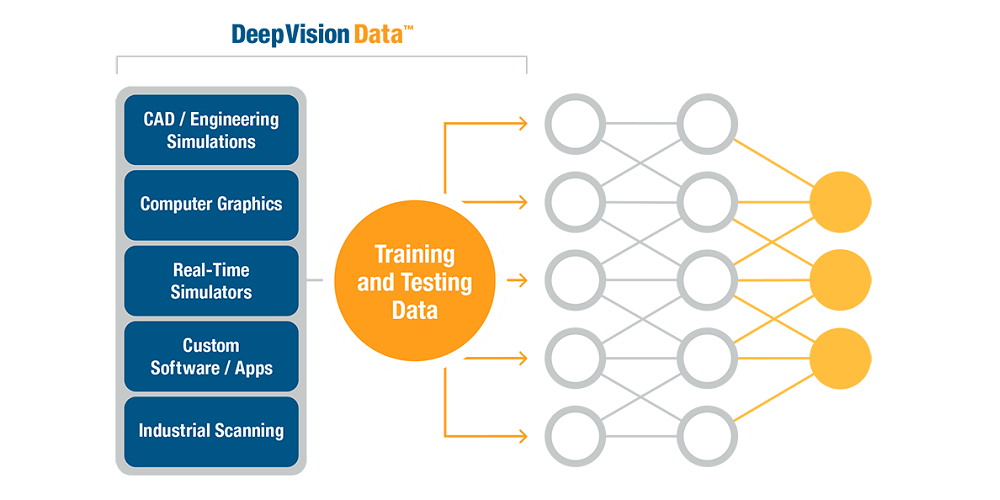* – This article has been archived and is no longer updated by our editorial team –
Below is our recent interview with Rick Schweet, President at Kinetic Vision and Deep Vision Data:

Q: What is Deep Vision Data?
A: Deep Vision Data creates synthetic training data for machine learning systems such as neural networks. Neural networks are computer systems that aren’t explicitly programmed, instead they are “trained” by providing them thousands or millions of examples. Self-driving cars, personal assistants like Alexa, Siri and Google Home, language translation and facial recognition are all applications of a class of machine learning called deep neural networks.
Q: What is synthetic training data?
A: Training a deep neural network is done by providing it a great number of examples of what it is trying to recognize. Traditionally the example dataset are actual photos, emails, recorded speech and other “real-life” information. This process works great for recognizing cats in photos because there’s millions of cat photos available to deep learning researchers. But what if physical training data is difficult or impossible to obtain? What if it’s confidential like medical imaging? That’s where synthetic training data becomes useful. Synthetic data is artificially created using computer graphics, real-time simulators, custom software and many other methods, and has been proven by researchers at Apple, Google, NVIDIA and many other companies to work as well as the real thing. Most often it supplements real data as opposed to completely replacing it.
 Recommended: Loyela Creates The Future Of Loyalty Programs Through Blockchain And AI
Recommended: Loyela Creates The Future Of Loyalty Programs Through Blockchain And AI
Q: What are other advantages of using synthetic data to train deep learning systems?
A: Speed and accuracy of system development. Consider the task of an autonomous automobile. A fleet of twenty cars can accumulate one million miles of training data in a year, but it’s possible that one billion miles of data is required to fully train an autonomous vehicle system. How is it possible to collect that much real-world data? The answer is that it’s not possible. What is possible is to create real-time driving simulators (think super-good video game) and then leverage those systems with a thousand people driving 24 hours a day. That’s exactly what NVIDIA’s Drive platform does. Now you’ve compressed the development time by a thousand-fold. Deep Vision Data has done the exact same thing in robotics applications.
Q: Are there other examples?
A: Yes. Synthetic training data was used by Apple researchers to create a more robust system for recognizing eye gaze direction. Researchers at UC Santa Cruz trained an image system with synthetic data to recognize various stages of galaxy formation for use with the Hubble Space Telescope. Most famously, DeepMind’s AlphaGo Zero trained itself to become the best Go player in world without any physical data at all. In fact, it beat the original AlphaGo (which was trained with thousands of human amateur and professional games to learn how to play Go) 100 games to zero. Nearly 3000 years of human knowledge and Go expertise apparently was wrong!
 Recommended: Blockchain Developers – Software Company That Specializes In ICOs And Blockchain Applications
Recommended: Blockchain Developers – Software Company That Specializes In ICOs And Blockchain Applications
Q: What are the potential future applications of machine learning systems?
A: Machine learning systems are expected to become a part of our everyday living just like the internet, mobile devices and social networking. Here’s a quote from someone that is most likely pretty knowledgeable on the subject:
“It is a renaissance, it is a golden age. We are now solving problems with machine learning and artificial intelligence that were … in the realm of science fiction for the last several decades. And natural language understanding, machine vision problems, it really is an amazing renaissance.”
Jeff Bezos
Amazon CEO
The main limitation in this future is the availability of training data. Physical data just isn’t available or cost-effective in all situations. In those cases people will turn to synthetic data to replace or augment their real data, and Deep Vision Data will be there to create it for them. We have the designers, engineers, software developers, real-time simulator developers and digital artists to handle almost any synthetic data creation challenge.
Activate Social Media:


